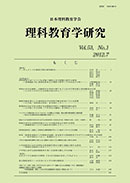Volume 61, Issue 3
Displaying 1-13 of 13 articles from this issue
- |<
- <
- 1
- >
- >|
Original Papers
-
2021 Volume 61 Issue 3 Pages 403-416
Published: March 31, 2021
Released on J-STAGE: March 31, 2021
Download PDF (2079K) -
2021 Volume 61 Issue 3 Pages 417-428
Published: March 31, 2021
Released on J-STAGE: March 31, 2021
Download PDF (1785K) -
2021 Volume 61 Issue 3 Pages 429-442
Published: March 31, 2021
Released on J-STAGE: March 31, 2021
Download PDF (2680K) -
2021 Volume 61 Issue 3 Pages 443-456
Published: March 31, 2021
Released on J-STAGE: March 31, 2021
Download PDF (3104K) -
The Elaboration Models for Proactive, Interactive, and Deep Learning: Focused on Ongoing Discussions2021 Volume 61 Issue 3 Pages 457-466
Published: March 31, 2021
Released on J-STAGE: March 31, 2021
Download PDF (2127K) -
2021 Volume 61 Issue 3 Pages 467-478
Published: March 31, 2021
Released on J-STAGE: March 31, 2021
Download PDF (2208K) -
2021 Volume 61 Issue 3 Pages 479-488
Published: March 31, 2021
Released on J-STAGE: March 31, 2021
Download PDF (1195K) -
2021 Volume 61 Issue 3 Pages 489-496
Published: March 31, 2021
Released on J-STAGE: March 31, 2021
Download PDF (742K) -
2021 Volume 61 Issue 3 Pages 497-513
Published: March 31, 2021
Released on J-STAGE: March 31, 2021
Download PDF (3360K) -
2021 Volume 61 Issue 3 Pages 515-526
Published: March 31, 2021
Released on J-STAGE: March 31, 2021
Download PDF (971K)
Note
-
2021 Volume 61 Issue 3 Pages 527-532
Published: March 31, 2021
Released on J-STAGE: March 31, 2021
Download PDF (2200K) -
2021 Volume 61 Issue 3 Pages 533-542
Published: March 31, 2021
Released on J-STAGE: March 31, 2021
Download PDF (3552K)
Notice
-
2021 Volume 61 Issue 3 Pages 543
Published: 2021
Released on J-STAGE: March 31, 2021
Download PDF (502K)
- |<
- <
- 1
- >
- >|
